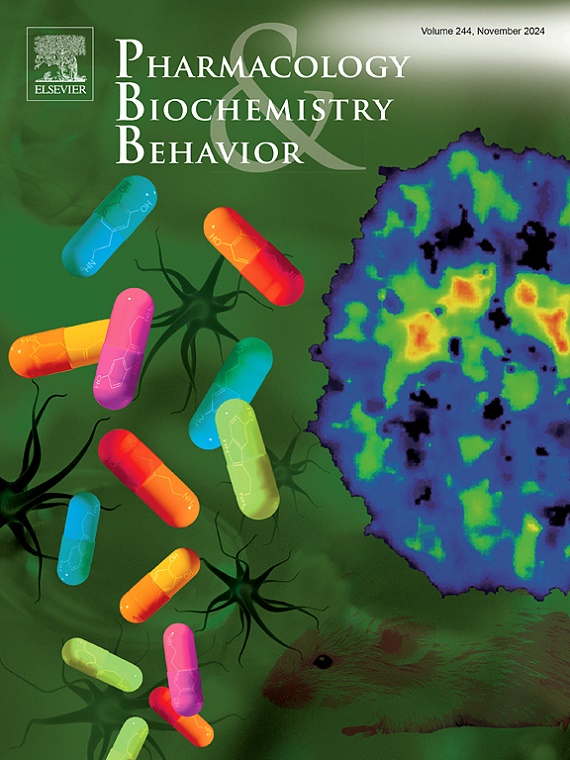Mescaline-induced behavioral alterations are mediated by 5-HT2A and 5-HT2C receptors in rats
IF 2.5
3区 心理学
Q1 BEHAVIORAL SCIENCES
引用次数: 0
Abstract
Rationale
Mescaline is a classical psychedelic compound with a phenylethylamine structure that primarily acts on serotonin 5-HT2A/C receptors, but also binds to 5-HT1A and 5-HT2B receptors. Despite being the first psychedelic ever isolated and synthesized, the precise role of different serotonin receptor subtypes in its behavioral pharmacology is not fully understood.
Objectives
In this study, we aimed to investigate how selective antagonists of 5-HT2A, 5-HT2B, 5-HT2C, and 5-HT1A receptors affect the behavioral changes induced by subcutaneous administration of mescaline (at doses of 10, 20, and 100 mg/kg) in rats.
Methods
We used adult male Wistar rats in all our experiments. We evaluated locomotor activity using the open field test, and assessed sensorimotor gating deficits by measuring prepulse inhibition (PPI) of acoustic startle reaction (ASR).
Results
While the highest dose of mescaline induced hyperlocomotion (p < 0.001), which almost all the other antagonists reversed (p < 0.05–0.001), the PPI deficits were selectively normalized by the 5-HT2A antagonist (p < 0.05–0.01). The 5-HT2C antagonist partially reversed the small PPI deficit induced by lower doses of mescaline (p = 0.0017).
Conclusion
Our findings suggest that mescaline-induced changes in behavior are primarily mediated by the 5-HT2A receptor subtype, with less pronounced contributions from the 5-HT2C receptor. The other antagonists had limited effects.
麦司卡林诱导的大鼠行为改变是由 5-HT2A 和 5-HT2C 受体介导的。
理由麦司卡林是一种典型的迷幻化合物,具有苯乙胺结构,主要作用于5-羟色胺5-HT2A/C受体,但也与5-HT1A和5-HT2B受体结合。尽管这是迄今为止分离和合成的第一种迷幻剂,但不同血清素受体亚型在其行为药理学中的确切作用还不完全清楚:本研究旨在探讨 5-HT2A、5-HT2B、5-HT2C 和 5-HT1A 受体的选择性拮抗剂如何影响大鼠皮下注射麦司卡林(剂量为 10、20 和 100 毫克/千克)所引起的行为变化:所有实验均使用成年雄性 Wistar 大鼠。方法:我们使用成年雄性 Wistar 大鼠进行所有实验。我们使用开阔地测试评估运动活动,并通过测量声学惊吓反应(ASR)的前脉冲抑制(PPI)来评估感觉运动门控缺陷:结果:虽然最高剂量的麦司卡林会诱发过度运动(p 结论:我们的研究结果表明,麦司卡林会诱发过度运动:我们的研究结果表明,麦司卡林诱导的行为变化主要由 5-HT2A 受体亚型介导,5-HT2C 受体的作用不太明显。其他拮抗剂的作用有限。
本文章由计算机程序翻译,如有差异,请以英文原文为准。
求助全文
约1分钟内获得全文
求助全文
来源期刊
CiteScore
6.40
自引率
2.80%
发文量
122
审稿时长
38 days
期刊介绍:
Pharmacology Biochemistry & Behavior publishes original reports in the areas of pharmacology and biochemistry in which the primary emphasis and theoretical context are behavioral. Contributions may involve clinical, preclinical, or basic research. Purely biochemical or toxicology studies will not be published. Papers describing the behavioral effects of novel drugs in models of psychiatric, neurological and cognitive disorders, and central pain must include a positive control unless the paper is on a disease where such a drug is not available yet. Papers focusing on physiological processes (e.g., peripheral pain mechanisms, body temperature regulation, seizure activity) are not accepted as we would like to retain the focus of Pharmacology Biochemistry & Behavior on behavior and its interaction with the biochemistry and neurochemistry of the central nervous system. Papers describing the effects of plant materials are generally not considered, unless the active ingredients are studied, the extraction method is well described, the doses tested are known, and clear and definite experimental evidence on the mechanism of action of the active ingredients is provided.

 求助内容:
求助内容: 应助结果提醒方式:
应助结果提醒方式:


